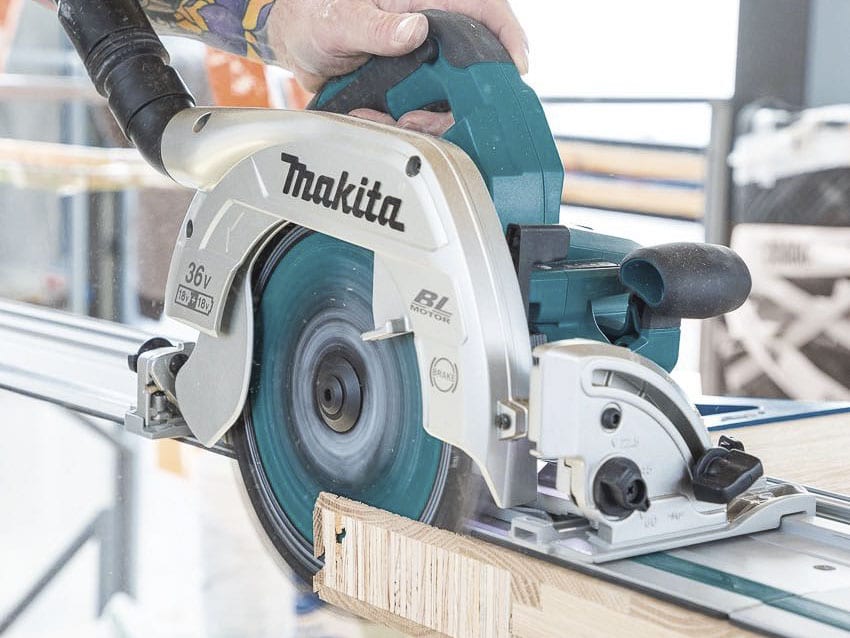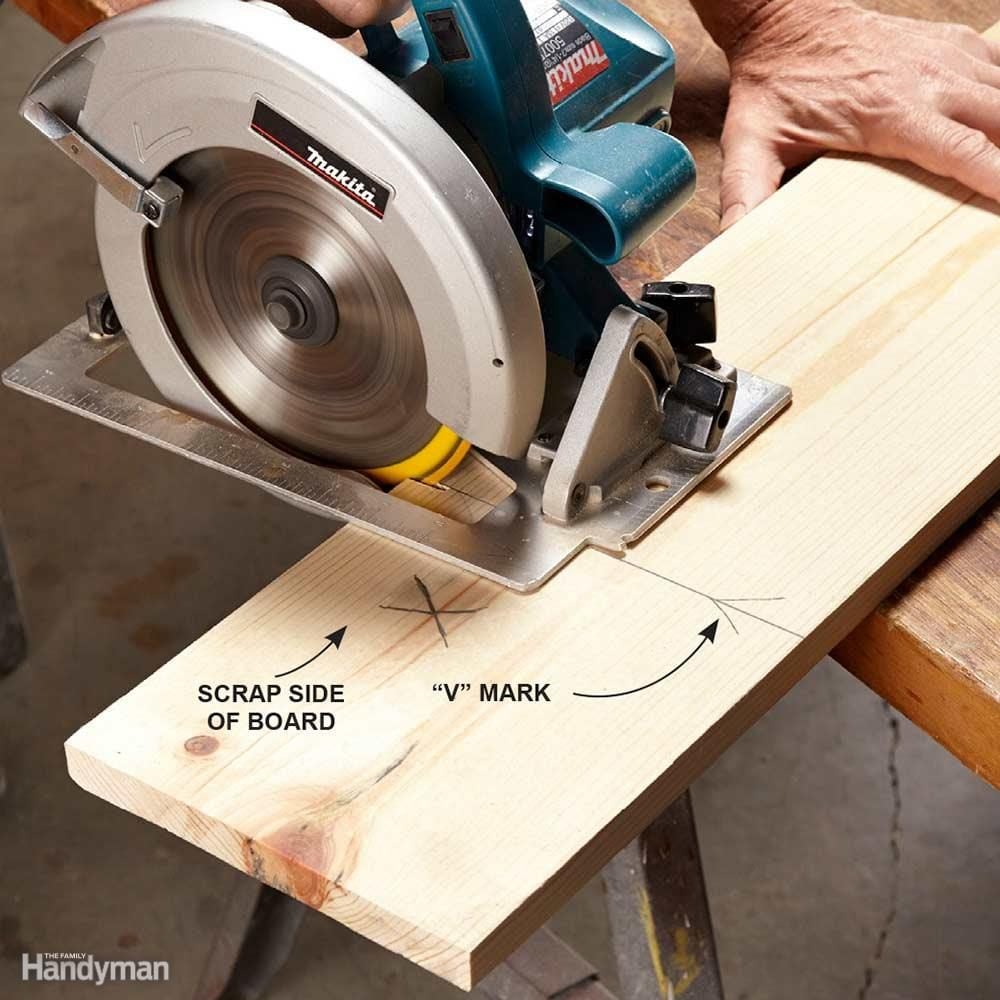If you’re wondering which side to cut with a circular saw, you’ve come to the right place! Using a circular saw can be both exciting and intimidating, but fear not, I’m here to guide you through it. So, let’s dive in and discover the answer together.
When it comes to cutting with a circular saw, one side takes the spotlight – the side from where the blade protrudes. Yes, that’s right! The blade of a circular saw cuts from the side that’s opposite to the motor. Understanding this simple rule will make your cutting experience much smoother and safer.
Now that you know which side to cut with a circular saw, let’s explore some essential tips and precautions to ensure you make accurate and precise cuts every time. So, grab your safety goggles and let’s get started!

Which Side Do You Cut With a Circular Saw?
When it comes to using a circular saw, it’s important to know which side you should be cutting from. This article will dive into the details and provide you with all the information you need to make accurate and efficient cuts. From understanding the anatomy of a circular saw to knowing the proper technique, we’ve got you covered. So let’s get started and explore which side you should cut with a circular saw!
The Anatomy of a Circular Saw: A Closer Look
Before we delve into the specifics of which side to cut with a circular saw, let’s take a moment to understand the basic components of this powerful tool. A circular saw typically consists of a circular blade, a motor, a handle, and a base or shoe. The blade is responsible for making the actual cuts, while the motor provides the necessary power. The handle allows for easy control and maneuverability, and the base or shoe helps guide the saw along the material being cut.
Now that we have a basic understanding of the circular saw’s anatomy, let’s move on to the question at hand: which side should you cut from?
Understanding Blade Orientation: Which Way Does the Saw Cut?
When using a circular saw, the blade spins in a clockwise direction. As a result, the saw will have a tendency to pull to the right. This means that if you cut from the right side of your material, the saw is more likely to veer off track and potentially cause inaccurate cuts or kickback.
To ensure accurate and safe cuts, it is recommended to position yourself on the left side of the material. This allows you to have a clear line of sight and better control over the saw’s movement. By cutting from the left side, you can guide the saw along the intended cutting path, reducing the risk of errors and ensuring smoother cuts.
While it may take some practice to get comfortable with cutting from the left side, it is a crucial technique to master for anyone using a circular saw.
The Benefits of Cutting from the Left Side
Cutting from the left side of the material offers several advantages. Firstly, it provides better visibility of the cutting line, allowing for more accuracy. When you’re able to see the line clearly, you can make adjustments and ensure that the blade stays on track.
Additionally, cutting from the left side allows for improved control and stability. As the saw pulls to the right, being on the left side gives you better leverage and control over the tool’s movement. This translates to smoother, more precise cuts.
Finally, cutting from the left side helps to mitigate the risk of kickback, which can be dangerous. Kickback occurs when the blade binds or encounters an obstacle, causing the saw to jerk back towards the user. By being on the left side, you can better resist the force of kickback and maintain control over the saw.
Tips for Cutting with a Circular Saw
Now that we know which side to cut from, let’s explore some tips to help you make the most of your circular saw:
- Always wear protective gear, including safety glasses and ear protection, to safeguard yourself from any potential hazards.
- Ensure that the blade is properly installed and tightened before starting any cutting tasks.
- Measure and mark your cutting line accurately to ensure precision.
- Take your time and let the saw do the work. Avoid applying excessive force or rushing the cut, as this can lead to mistakes or accidents.
- Use a guide or a straight edge to help maintain a straight cutting path.
- Keep the saw motor running at full speed throughout the cut to prevent any stalling or binding.
- Ensure that the material being cut is properly supported and secured to avoid any movement or shifting.
- Practice makes perfect! Take the time to familiarize yourself with the circular saw and its operation before tackling more complex projects.
The Versatility of Circular Saws
In addition to knowing which side to cut from, it’s worth noting that circular saws are incredibly versatile tools that can be used for a wide range of applications. From cutting lumber to plywood, and even metal with the appropriate blade, these tools are a staple in many woodworking and construction projects.
Whether you’re a DIY enthusiast or a professional contractor, a circular saw is a valuable addition to your toolkit. With proper technique and safety precautions, you can achieve precise and clean cuts, making your projects a breeze.
Maintaining and Caring for Your Circular Saw
Like any tool, a circular saw requires regular maintenance to ensure optimal performance and longevity. Here are a few tips for caring for your circular saw:
- Keep the blade clean and free from debris to prevent any build-up that could affect its cutting ability.
- Regularly inspect the saw’s cord for any signs of wear or damage. If you notice any issues, have it repaired or replaced by a professional.
- Store your circular saw in a dry and secure location to protect it from moisture and potential damage.
- Periodically check the saw’s base or shoe for any signs of warping or damage. If needed, replace the base to maintain proper alignment and accuracy.
- Follow the manufacturer’s guidelines for lubricating any moving parts to ensure smooth operation.
Conclusion
Knowing which side to cut from can significantly impact the accuracy and safety of your cuts when using a circular saw. By positioning yourself on the left side and following proper cutting techniques, you can achieve precise and clean cuts. Remember to always prioritize safety and wear appropriate protective gear while operating any power tools. With practice and attention to detail, you’ll become a master of the circular saw in no time!
Key Takeaways: Which Side Do You Cut With a Circular Saw?
- When using a circular saw, always position yourself on the side opposite of the fence or guide.
- The blade of the circular saw should be set to cut on the side that is facing away from you.
- Make sure to adjust the cutting depth of the circular saw to match the thickness of the material you are cutting.
- Always wear safety goggles and appropriate protective gear when operating a circular saw.
- Remember to follow the manufacturer’s instructions and guidelines for using a circular saw safely and effectively.
Frequently Asked Questions
Welcome to our FAQ section on using a circular saw! Here, we’ll answer common questions about which side to cut with a circular saw. Whether you’re a beginner or have some experience, this guide will provide helpful insights.
1. How do I determine which side to cut with a circular saw?
When using a circular saw, it’s preferable to cut on the side where the circular saw’s teeth are moving downward. This means you should position the material you’re cutting on the opposite side of the saw from where you’re standing. For right-handed users, this usually means cutting on the right side of the marked line, while left-handed users cut on the left side.
Cutting on the correct side not only enhances your visibility of the cutting line but also minimizes the risk of the circular saw catching or binding on the material, reducing the chances of accidents or kickbacks.
2. Can I cut on the opposite side of the circular saw?
In general, it is not recommended to cut on the opposite side of a circular saw. This means that right-handed users should avoid cutting on the left side of the marked line, and left-handed users should avoid cutting on the right side. While it may be tempting to do so for convenience, it can lead to reduced visibility of the cutting line and increase the risk of accidents.
By following the recommendation to cut on the same side as the moving teeth, you can maintain better control over the circular saw, prevent binding or catching of the blade, and ensure a cleaner, smoother cut.
3. Are there any exceptions to the rule of cutting on the same side as the moving teeth?
While it is generally best to cut on the same side as the moving teeth of a circular saw, some experts might recommend an exception for certain specialized cuts. For example, when making bevel cuts or miter cuts, it may be necessary to cut on the opposite side. However, these situations often require advanced knowledge and techniques.
It’s important to note that unless you have specific experience and expertise in these specialized cuts, it’s best to stick to the general rule and cut on the same side as the moving teeth for your own safety and to achieve accurate, clean cuts.
4. What steps should I take to ensure safe cutting with a circular saw?
When using a circular saw, it’s crucial to prioritize safety. Start by wearing protective gear such as safety goggles and ear protection. Always follow the manufacturer’s instructions and make sure the saw is properly adjusted and in good working condition.
Additionally, it’s important to secure the material you’re cutting and use clamps or other tools to prevent it from moving. Keep a firm grip on the saw and maintain a stable stance throughout the cut. If you’re a beginner, consider seeking guidance from a more experienced user or taking a class on how to safely operate a circular saw.
5. Are there any maintenance tips for keeping a circular saw in good condition?
To keep your circular saw in good working condition, regular maintenance is essential. After each use, clean the saw of any dust or debris, paying extra attention to the blade and the area around it. Make sure the blade is sharp, and if it’s dull or damaged, replace it promptly.
Inspect the saw’s cords and handles for any signs of wear or damage. Lubricate moving parts as recommended by the manufacturer. Lastly, store the circular saw in a safe and dry place, preferably in a case designed for its storage, to protect it from moisture or accidental damage.

Summary
So, which side do you cut with a circular saw? It’s important to remember that the blade of the saw cuts on the bottom side. This means that when using a circular saw, you should position the material you’re cutting with its good side facing down. By doing this, you’ll get clean and smooth cuts with the circular saw.
So, to recap, if you want the best results when using a circular saw, remember to cut with the good side facing down. This simple tip will help you achieve precise and clean cuts every time you use a circular saw. Happy cutting!
